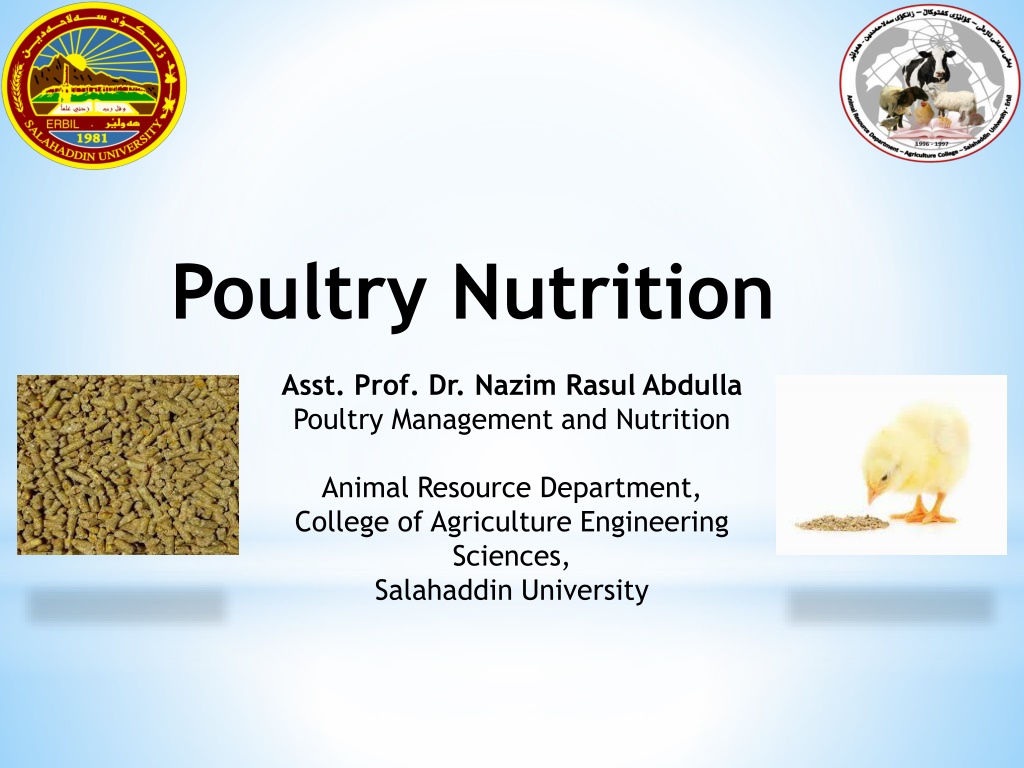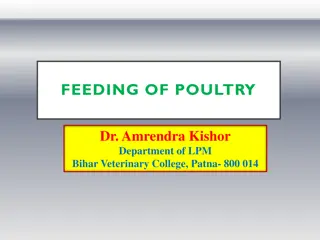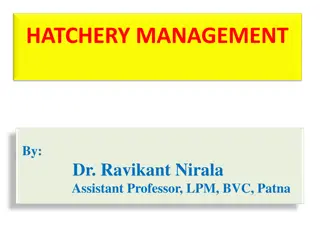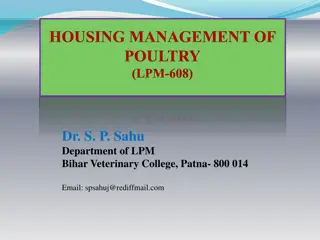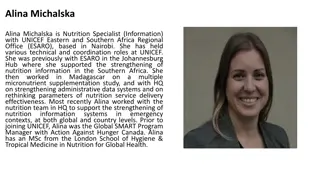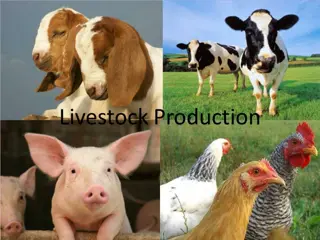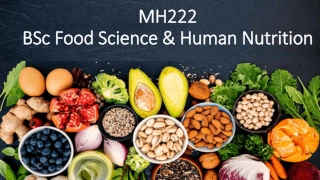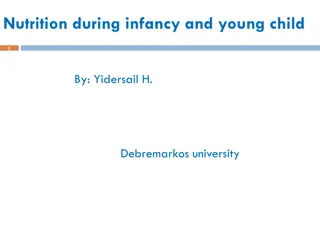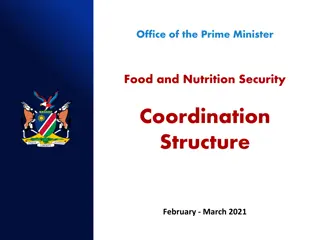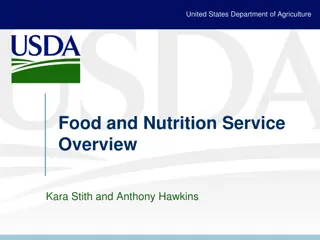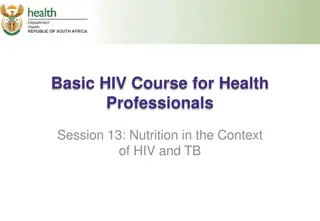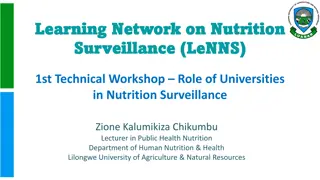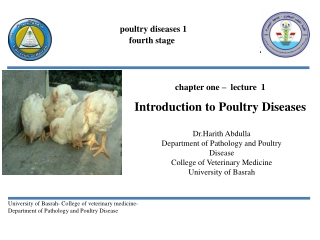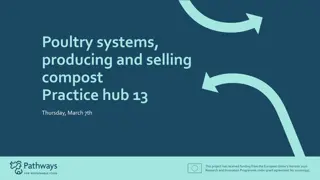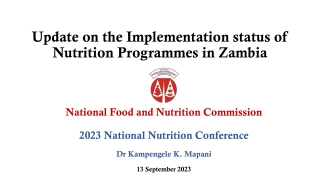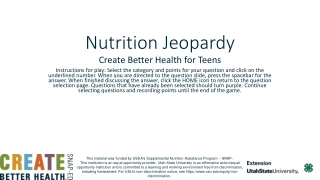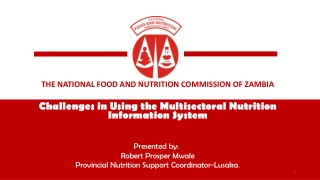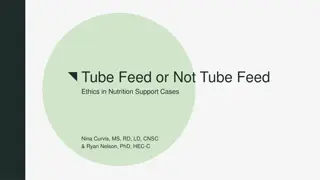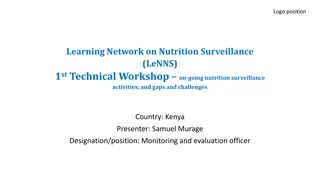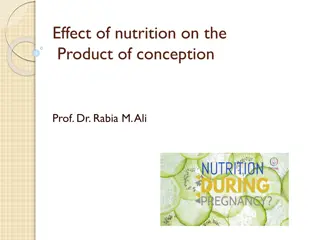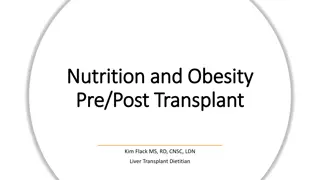Poultry Nutrition
Developments in poultry nutrition have led to increased productivity in the industry over the past 20 years. The focus is shifting towards life-cycle feeding programs for different bird classes rather than individual diets. Poultry diets consist of various feedstuffs providing essential nutrients for growth, reproduction, and health, with energy primarily sourced from carbohydrates, fats, and proteins. The future emphasis in poultry nutrition involves adapting to changing production conditions and goals to optimize feeding programs effectively.
Download Presentation

Please find below an Image/Link to download the presentation.
The content on the website is provided AS IS for your information and personal use only. It may not be sold, licensed, or shared on other websites without obtaining consent from the author. Download presentation by click this link. If you encounter any issues during the download, it is possible that the publisher has removed the file from their server.
E N D
Presentation Transcript
Poultry Nutrition Asst. Prof. Dr. Nazim Rasul Abdulla Poultry Management and Nutrition Animal Resource Department, College of Agriculture Engineering Sciences, Salahaddin University
Quiz! In one broiler farm, the average body weight was 3 kg at 49 days of age and Feed/efficiency was 1.8, find the total feed consumption for the total bird in the farm, if the total number of birds in the farm was 5000? FCR= Feed Intake/ Body weight
Introduction Over the last 20 years, developments in poultry nutrition have paralleled, or made possible, increased productivity of the various poultry industries. 1.400 Kg 1.700 Kg 2.150 Kg 2.850 Kg
As production conditions and goals have changed, we have been able to revise our estimates of nutrient requirements. Greater variation in production goals has imposed some degree of complication to feeding programs, because global recommendations are now often not applicable.
The future emphasis in poultry nutrition must be the development of life-cycle feeding programs for various classes of birds, rather than consideration of individual diets in isolation. Unfortunately, there is still few research information available that views recommendations within the context of an overall program.
Poultry diets are composed primarily of a mixture of several feedstuffs such as cereal grains, soybean meal, animal by-product meals, fats, vitamin and mineral premixes. These feedstuffs, together with water, provide the energy and nutrients that are essential for the bird's growth, reproduction, and health. The energy necessary for maintaining the bird's general metabolism and for producing meat and eggs is provided by the energy- yielding dietary components, primarily carbohydrates and fats, but also protein.
Poultry diets also can include certain constituents not classified as nutrients, such as xanthophylls (that pigment and impart desired color to poultry products) The "unidentified growth factors" claimed to be in some natural ingredients Antimicrobial agents (benefits of which may include improvement of growth and efficiency of feed utilization).
General definition of poultry nutrition: Nutrition is an action of supporting body tissues with required nutrients included in the feed to support growth, egg production, reproduction, movement, feed intake, digestion, and absorption of nutrients in the feed also transportation of those nutrients to the cell sufficiently.
Poultry feed: Is food for farm poultry, including chickens, ducks, geese and other domestic birds. Feed for poultry mostly consists of grain. A portion of commercial feed, typically around a quarter, is known as bulk and is indigestible.
Poultry nutrition: There are around 40 nutrients necessary to be included in the diet of poultry by adequate and balanced levels allowing the genetic potency to represent as growth and production.
When nutrients inefficient some syndromes appear interacted with some diseases syndrome, thus a wrong idea given to the producer about the problem facing the flock. The producer or the veterinarian expects that the problem related to microbial or viral infection or it is a disease problem.
When the inefficiency is partial and interacts with some diseases the diagnoses will be difficult attribute to malnutrition or infections or toxicity. The feed must remain clean and dry, contaminated feed can infect poultry. Damp feed encourages fungal growth. Mycotoxin poisoning, as an example, is "one of the most common and certainly most under-reported causes of toxicoses in poultry".
Diseases can be avoided with proper maintenance of the feed and feeder The development of poultry production based on the science of poultry nutrition in which the nutrition influence directly on poultry products.
The main goal of poultry nutrition The main goal of poultry nutrition is to prepare and formulate sufficient diet to the bird in all steps of production with higher income to the producer in the same time offer the adequate welfare to the bird.
The genetic potential for growth of the modern poultry (such us broiler chickens) is continuously improving by 50 g each year. Therefore the marketing age of broilers decreases yearly by an average of 0.75 day. It is estimated that the same broiler has the potential to double this performance.
Nowadays, the standard in broiler performance is achievement of 2.8 kg live weight with a feed conversion ratio of less than 1.72 at 42 day of age.
Poultry nutrition is an integral part of poultry production. It has changed drastically as a consequence of developments in the other disciplines of animal science and also because of changes in poultry husbandry practices. Developments in disciplines have been so strongly related to one another that one discipline could not have developed in isolation without developments in the other. For instance, poultry have been bred to have an increased production, but the expression of this enhanced genetic potential was only possible by continuous adjustment of nutrition to the genotype of the bird.
On the other hand, developments in poultry properties have led to research on possible changes in nutritional needs with regard to these developments. Similar connections can be made between nutrition and housing and between nutrition and developments in preventive medicine. Many changes have taken place in animal production systems in many countries after the 1950 s.
Table 1. Changes in poultry production in the Netherlands in the two last decades of feed efficiency is feed/gain for broilers and feed/egg mass for layers. Broilers Weight (g) Feed (kg) Feed/efficiency 1.88 1.70 1.50 1980 1990 2000 Layers 1980 1990 2000 1700 ? 2300 2000 3.2 3.4 ? 3.5 2.50 2.20 2.05 - - - - - -
For commercial poultry farming, feed serves as the largest cost of the operation (around 60- 70%). Thus the nutrition gains more consideration than other factors. The use of new technologies to improve this section is in great demand to achieve least cost of the efficient feed to higher performance with fewer prices.
In industrial agriculture, machinery is used to automate the feeding process, reducing the cost and increasing the scale of farming. The main goal of the nutritionists is achieving higher production with the least cost of feeding by using cheapest feed ingredients available in the market. Nutrition cost Chick and other goods cost
*Steps of feed chain in the body Consumption Digestion Absorption Transportation
protein level in the diet 25 20 20 Protein level % 18 17 17 16 15 15 15 10 5 0 1 4 8 12 16 20 24 Hen age (Week) * Figure 1: demonstrates the requirements of crude protein in the diet of layer due to the age of the bird.
Comparison between the poultry and ruminant: General comparison between birds and other animals Birds Other animals Lower birds They are less 1. High activity and movements than the 2. More sensitive to the exposure to environment Short life and production cycle 3. Longer production cycle life and
Nutrient requirements of poultry is higher than the ruminant ? because of the 1. Rapid growth 2. Higher feed conversion 3. Higher rate of respiration 4. Higher heart pulse 5. Higher body temperature
The diet of birds should be: 1. In small amount 2. Concentrated 3. Easy to digest 4. High in feeding value Because 1. The bird hasn't teeth.The grinding of the feed particles happen in the gizzard. 2. The gastro intestinal tract (GIT) small with small capacity 3. The feed pass quickly through the GIT (3-8h) 4. The time of diet exposure to the GIT secrets (Hcl, bile salt and enzymes) is too short.
The digestion in ruminants is: mechanical, microbial and enzymatic but in birds is: enzymatic only therefore the diet should be composed mainly from concentrated form with low fiber content
Classification of poultry diet: 1- Maintenance ration: For maintain the body heat to the rate that sufficient to the basic voluntary muscles movements (movement and walking) and involuntary muscle movements (heart. Respiratory system and GIT). 2- Production ration: A part of the feed to support the body with essential nutrients required for production of meat and egg.
The quantity of feed, and the nutritional requirements of the bird, depends on: the weight and the age of the poultry as well as the environment.
Factors affecting the feed formulation Feed formulation depends on many factors which are: 1. Specification of each feed ingredient 2. Its effects on the final product of the bird (meat and egg) 3. Rate of the utilization from nutrients included in the feed ingredient
For each species, the National Research Council (NRC) includes suggested requirements for: 14 Amino acids, 12 minerals, 13 vitamins and one fatty acid. These days it was been possible to achieve the true and efficient levels of each nutrient through many scientific institutes such as NRC and others.
